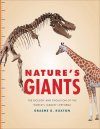Popular Science
By: Graeme D Ruxton(Author), Norman Owen-Smith(Foreword By)
224 pages, 350 colour photos and colour illustrations
Giants fascinate us and Graeme Ruxton here gives a popular account of giants and the biology of size.
![Nature's Giants Nature's Giants]()
Click to have a closer look
About this book
Customer reviews
Biography
Related titles
Recommended titles
About this book
The past and present giants of our world – dinosaurs, whales, and even trees – are a source of unending fascination, and their sheer scale is awe-inspiring. Size is integral to the way that organisms experience the world: a puddle that a human being would step over without thinking is an entire world to thousands of microscopic rotifers. But why are creatures the size that they are? Why aren't bugs the size of elephants, or whales the size of goldfish?
In this beautifully illustrated new book, biologist Graeme Ruxton explains how and why nature's giants came to be so large, for example, how decreased oxygen levels limited the size of insects and how island isolation allowed small-bodied animals to evolve larger body sizes. Through a diverse array of examples, from huge butterflies to giant squid, Ruxton explores the physics, biology, and evolutionary drivers behind organism size, showing what it's like to live large.
Customer Reviews
Biography
Graeme D. Ruxton is professor of biology at the University of St. Andrews in Scotland and fellow of the Royal Society of Edinburgh.
Popular Science
By: Graeme D Ruxton(Author), Norman Owen-Smith(Foreword By)
224 pages, 350 colour photos and colour illustrations
Giants fascinate us and Graeme Ruxton here gives a popular account of giants and the biology of size.
"We are dwarfed by many animals, from the blue whale to the mighty Tyrannosaurus rex. Size poses its own physical challenges as expertly explained by Graeme Ruxton in a book chock-full of fun facts about the biggest animals and the reasons for their success or failure in the natural world."
– Frans de Waal, author of Are We Smart Enough to Know How Smart Animals Are?
"This thoroughly researched and beautifully presented book not only invites us into awe; its pages also celebrate the dynamic living processes that gave rise to all creatures, great and small."
– David George Haskell, author of The Songs of Trees
"The biggest animals and plants in nature command our attention. They are the monsters of our nightmares, or the objects of our awe. Nature's Giants is a wonderful tour of their oversized world, combining gorgeous photographs and illustrations with the latest insights that science has to offer about how life can get so large."
– Carl Zimmer, author of She Has Her Mother's Laugh: The Powers, Perversions, and Potential of Heredity
"An attractive and accessible natural history of large organisms."
– Noel A. Heim, Stanford University
"[...] Not in-depth or specific enough for the committed student, not beautiful enough for a coffee table, my guess is that the ideal readers are the young and scientifically precocious. For them, this book certainly provides much to be pored over and be enthused by if more as a springboard to further enquiries than anything more substantial."
– D. Cornish, The Biologist 66(5) October/November 2019



















![Sekaiichi no Kyodai Seibutsu [Nature's Giants] Sekaiichi no Kyodai Seibutsu [Nature's Giants]](http://mediacdn.nhbs.com/jackets/jackets_resizer/25/257008.jpg)



























